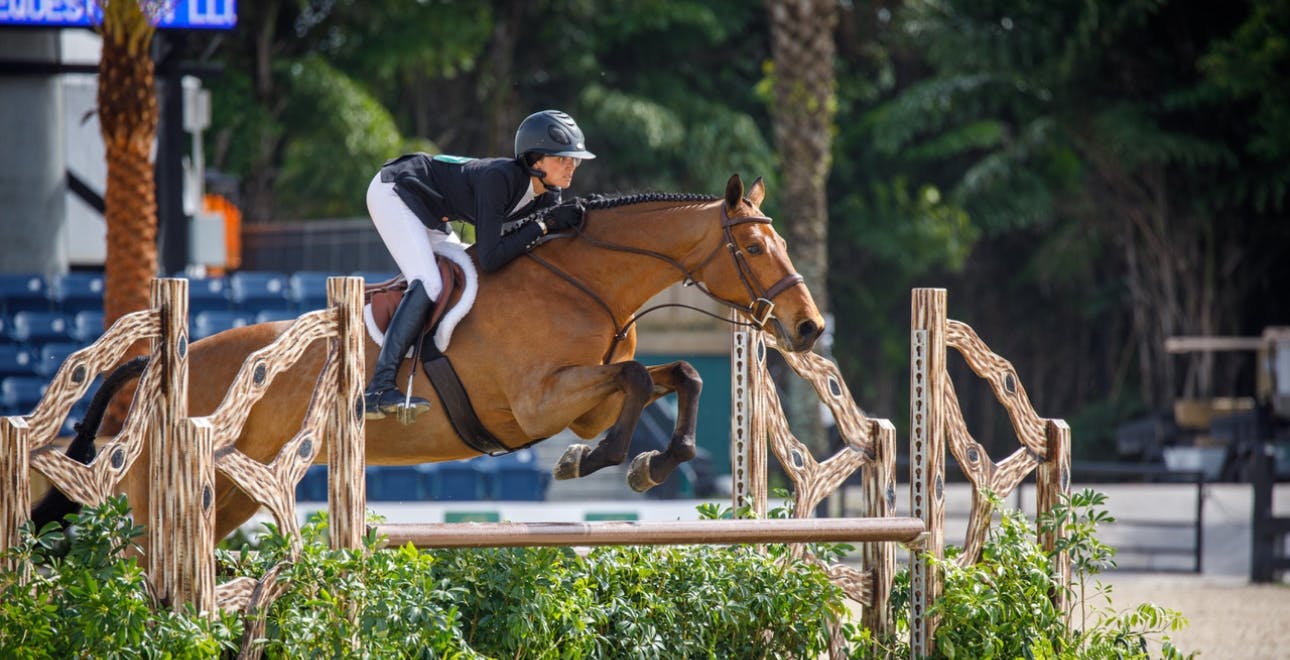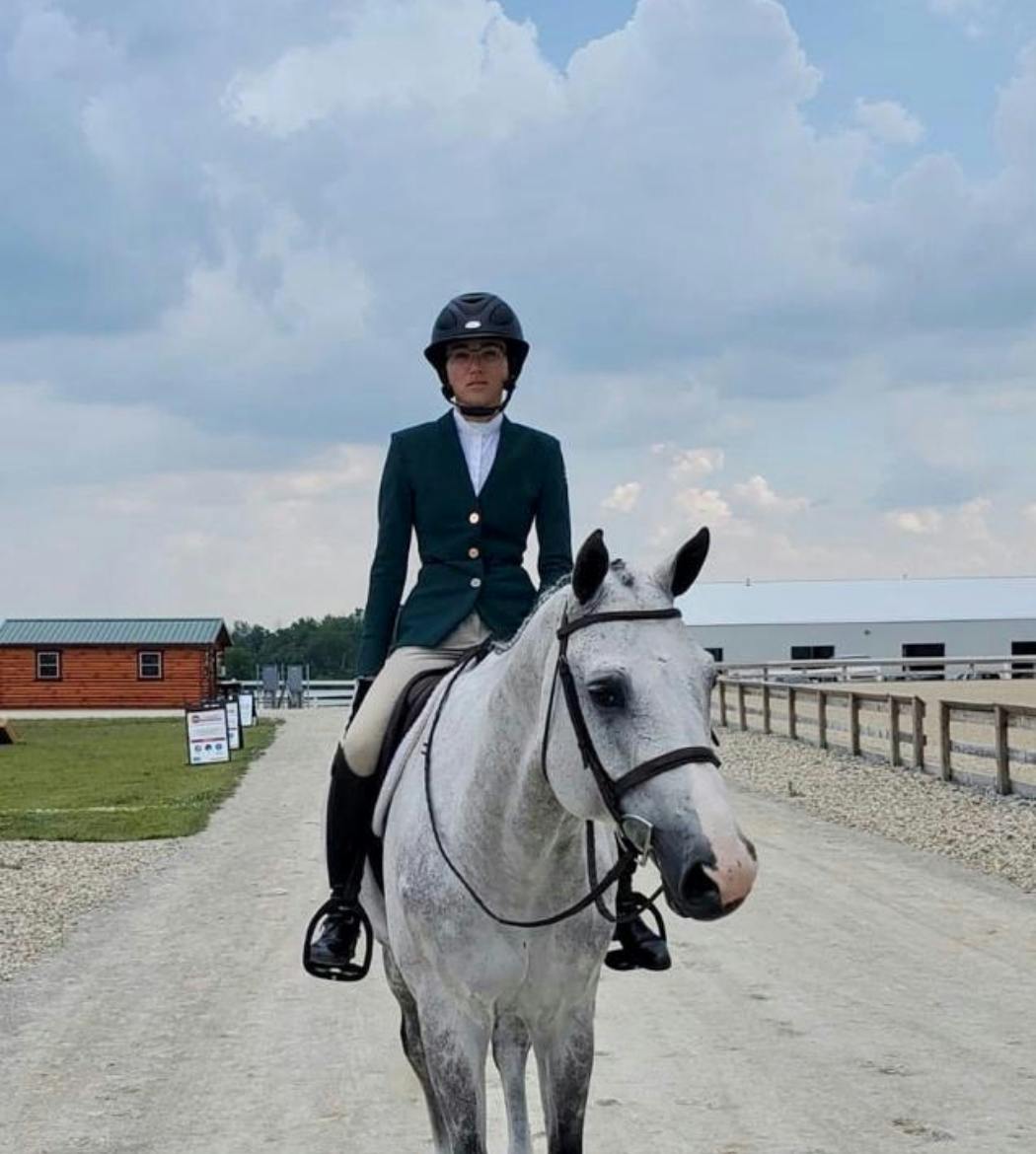X-Balance
- CA$130.00
CA$260.00
Discover a selection of products designed for hunter riders:…

CA$720.00
CA$210.00
Hunter is an equestrian sport that involves completing a course of jumping obstacles as elegantly as possible. Every detail counts, including the harmony of the rider-horse pair. Horse Pilot reveals its origins, its rules, right down to the essential skills needed to excel in this riding discipline.
Halfway between show jumping and dressage competition, hunter riding focuses on the technical quality of show jumping. It thus prioritizes elegance, fluidity and finesse of execution through a harmonious relationship between rider and horse.
Hunter originated in the United States. It was used to train horses for hunting with hounds between periods of venery. This explains the revival of elements of outdoor riding, such as hunting courses. This equestrian discipline has particularly flourished in the United States, where it is a fundamental step in learning show jumping.
Unlike classic show jumping (CSO), where speed predominates, Hunter puts the emphasis on style. Riders are judged on their ability to complete the course with grace, fluidity and harmony. The various types of obstacles are massive and low, and the approaches are clear and safe. The discipline values the horse's dressage, the couple's presentation, the rider's technical mastery and precision of execution.
Hunter Style is one of the two main event categories. It evaluates the horse or pony. Judges score the horse's model (depending on breed), jumping style and locomotion. The other category, Hunter Equitation, evaluates the skills of the rider, whether amateur or pro. This includes stance, riding ability and use of aids. Mixed events combine the requirements of both disciplines.
This equestrian practice requires both technical mastery and a strong connection between rider and mount.
Dressage plays a central role in hunter riding. Horses are responsive to the rider's aids and capable of executing smooth transitions. Dressage figures are imposed between jumps. The quality of trot jumps, changes of foot and stops must offer a fluid and harmonious course.
Horses clear low obstacles with precision, finesse and without contact with the bars. Movements are natural, measured, without excess or unnecessary effort. The jump is adapted to the height of the obstacle, and the horse seems to enjoy the course. Stride contracts, the quality of the layout, the regularity of the gaits and the discretion of the aids are key elements.
The hunter rider stands in constant balance to smoothly accompany his horse's movements. This keeps him light on the horse's back and in precise control. He maintains three points of contact in seated balance, or two points for a more advanced posture. His gaze favors anticipation, always directed towards the next obstacle or imposed passage.
Hunter riding emphasizes versatility and maneuverability through its variety of tests. To succeed in them, hunter riders must maintain a constant harmony between themselves and their horse.
Judges evaluate the hunter horse's elegance of movement and directness over obstacles. Fluid, regular locomotion and good cadence are major criteria. The horse is capable of executing graceful jumps with constant speed over the course. Massive obstacles require the horse to be supple and powerful to overcome each obstacle smoothly.
Hunter events require riders to be highly versatile. Handling in particular, as the courses feature lines, transitions, imposed figures and stride contracts. These are all technical difficulties that the rider must solve with the ability to turn short or choose precise trajectories. His jumps are executed with delicacy, elegance, fluidity and responsiveness.
Hunter's main challenges lie in the untimed approach, constant control of the horse and precise execution. The handling tests, with lateral jumps and tight curves, test the responsiveness of both rider and horse. Hunter requires great concentration and a high level of skill. Dressing the horse and presenting the pair add to the complexity.
Hunter equestrian events usually take place over the course of one day, starting with a reconnaissance of the course. These equestrian events are orchestrated by a ringmaster.
Two main categories of events dominate. Each awards points on several elements. From this score penalties are deducted to determine the final ranking.
The score evaluates the mount, spread over 8 tests. The judges appreciate the horse's general harmony (linked to its breed) and the elegance of its gaits. Next, the horse's jumping style is observed. Then comes technique, including cadence, fluidity of lines and quality of obstacle approaches.
This category focuses on the rider and his achievement of the difficulties imposed on the course. His attitude, balance, ease, eye contact and discreet use of aids are all factors evaluated. This category comprises 16 events classified according to five types: compulsory figures, maneuverability, Grand Prix and Combined CSO.
The layout of the hunter course is similar to a dressage test with an obstacle course. Depending on the level of competition and event category, the number and height of obstacles vary, as do the figures imposed. For example, the layout may include jumps at a trot or canter, a circle or changes of foot.
The ringmaster plays a crucial role. He designs the courses, defines the type of obstacles and their height (fixed or moving obstacles). He determines the distances to be respected before jumping the obstacle and the compulsory figures. He ensures that everything runs smoothly and safely. Riders who follow his instructions carefully maximize their chances of a successful competition.
Hunter riding is all about aesthetics and tradition. And this applies as much to the way the horse is ridden, as to the horse's grooming and the rider's attire. Everything is regulated, right down to the smallest piece of equipment.
The entire hunter riding outfit is a showcase for the history and traditions of this equestrian sport. The dark tweed jacket is complemented by a white shirt and tie. The bomber or helmet ensures safety, with impeccable classic riding boots. Leather gloves complete the ensemble.
Varied terrain defines the hunter course, especially for line obstacle combinations. Rivers, hurdles and fences recall the discipline's origins in hunting with hounds. The ringmaster uses movable bars, stanchions, studs and plants and even tarpaulins to create them.
Appearance in hunter is a matter of tradition. The presentation of competitors and their mounts must be impeccable, sober and elegant. The horse's mane and toupee are plaited, the tail braided, no frills, and the coat glossy. Details such as the reins or stirrups used, or a rug of the same shape as the saddle, are important. Any deviation from the harnessing will result in a penalty.
Originating in the USA, hunter riding is experiencing significant growth in France and gaining in popularity on the international scene. This riding sport has won over the equestrian world and experienced amateurs and beginners alike.
In France, many equestrian centers and riding schools are responding to the growing craze with hunter-related training and competitions. As a result, this equestrian activity is gradually establishing itself as a complementary discipline to traditional equestrian sports such as show jumping.
Equestrian hunter competitions for horses and ponies are multiplying in France and Europe. The Fédération Française d'Équitation (FFE) establishes a permanent ranking of national competitions, including the "National Hunter FFE" circuit.
Internationally, Canada gives hunter riding a prominent place with the Quebec Games. As for the United States, hunter sport retains a significant presence.
Growing interest in this discipline, its values focused on the horse's well-being, lightness and harmony are contributing to its rapid development. The FFE offers courses and numerous events to ensure that hunter riding remains a permanent fixture on the French equestrian scene.
On the international scene, the diversification of equestrian competitions and growing participation are positive indicators. International organizations are getting involved to promote Hunter worldwide. This promises a promising future.
With its high level of skill, hunter riding is a valuable springboard for riders who want to excel in show jumping. Thanks to the commitment of horse clubs, federations and riders, it continues to expand. So, whether you're a beginner or an experienced rider, dive into the world of Hunter and discover the beauty of this unique discipline.
